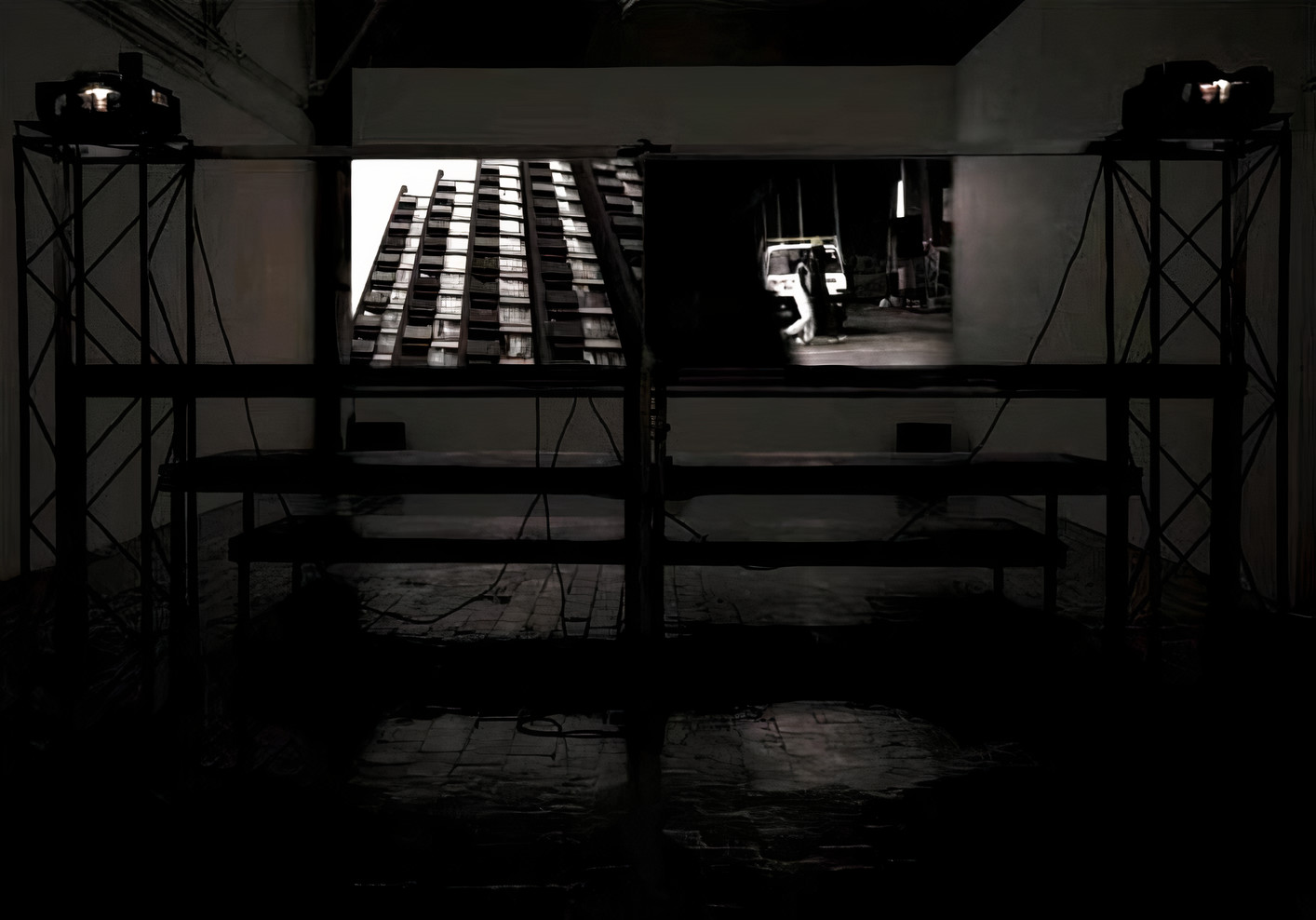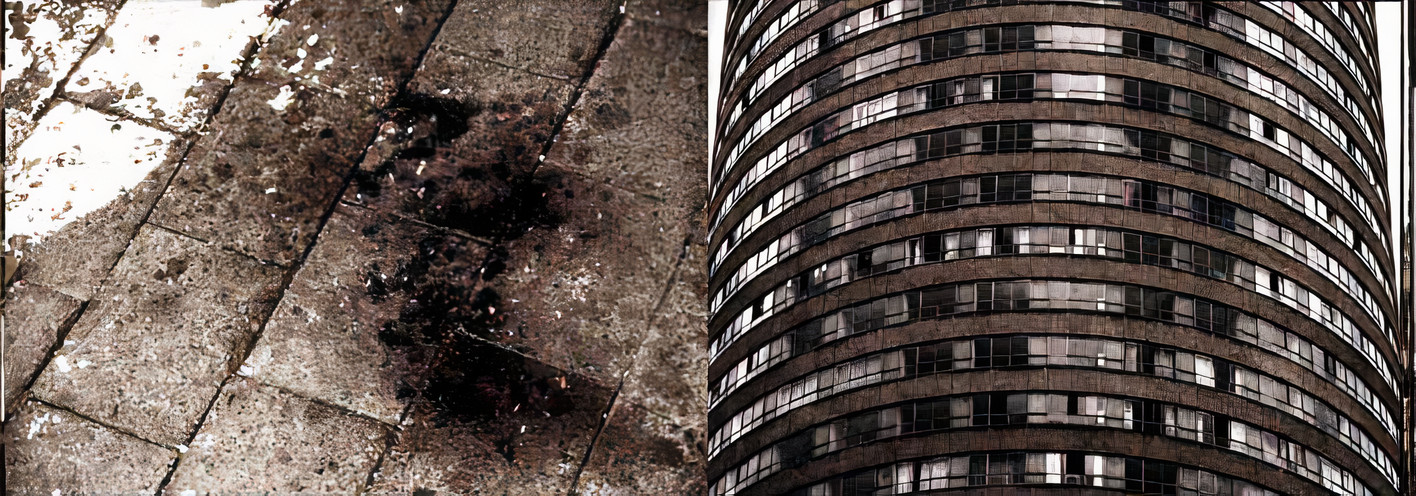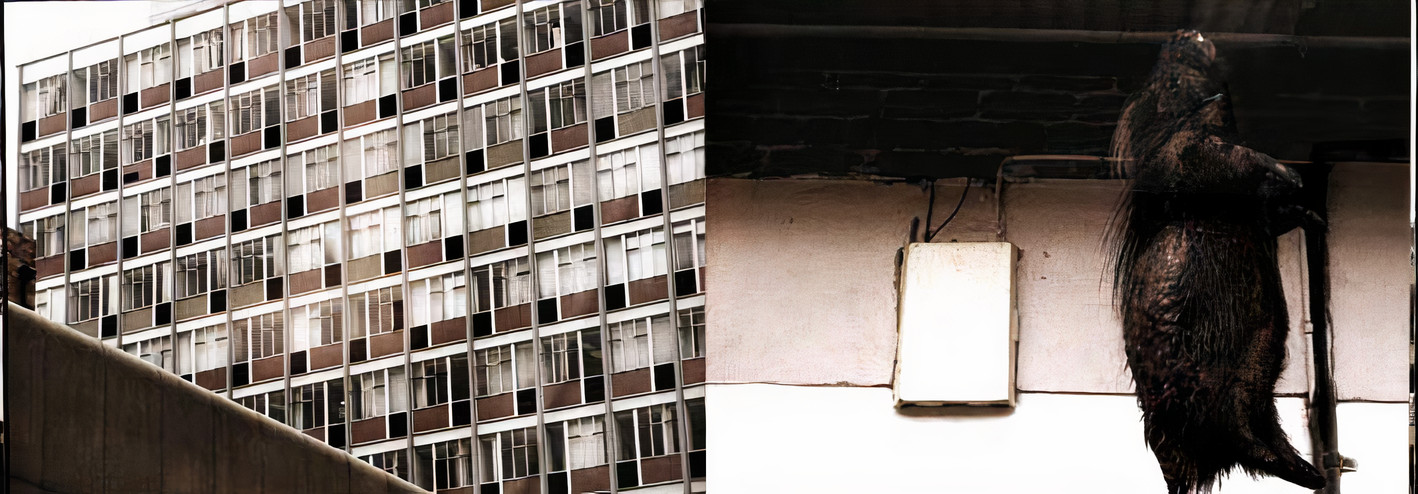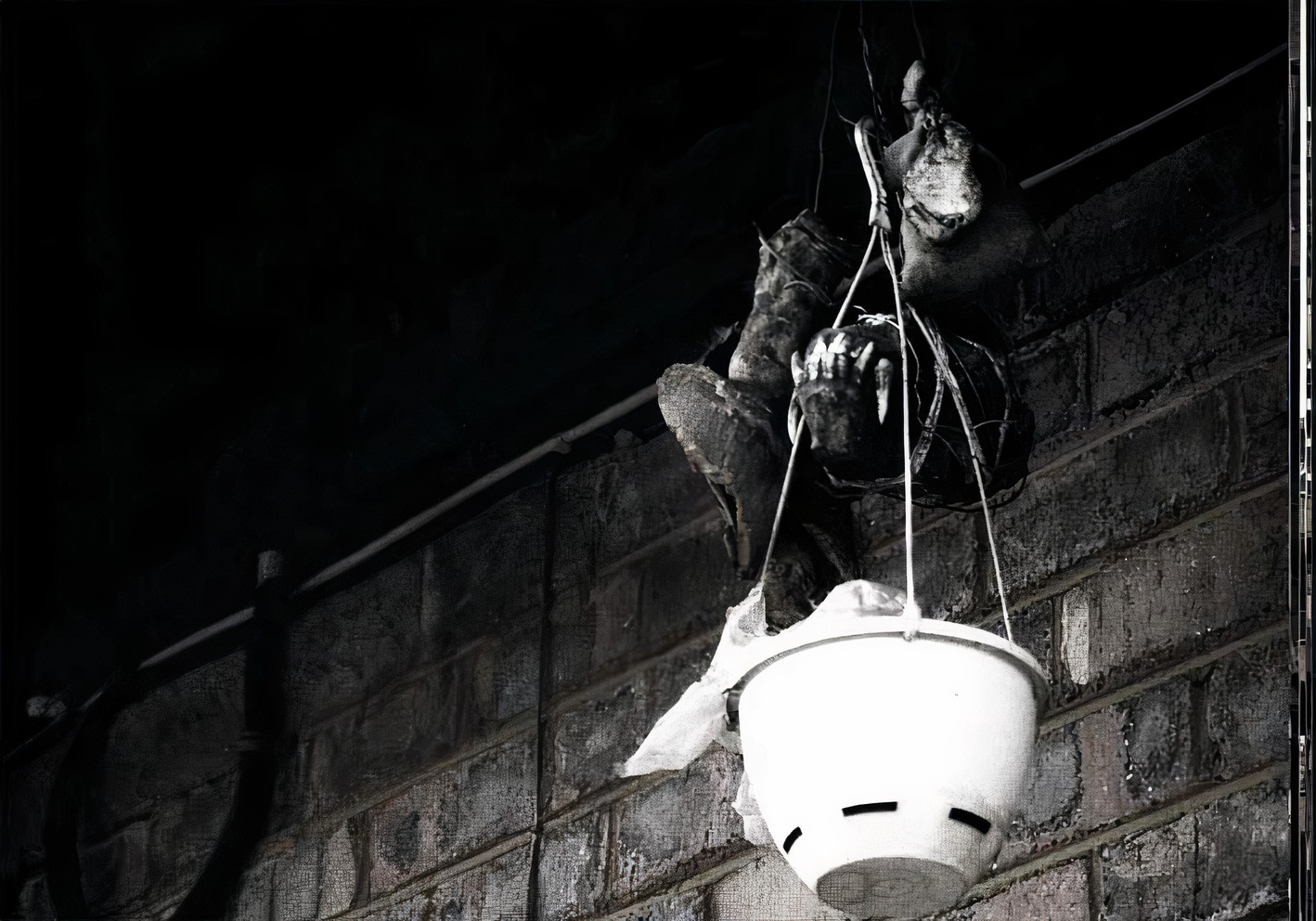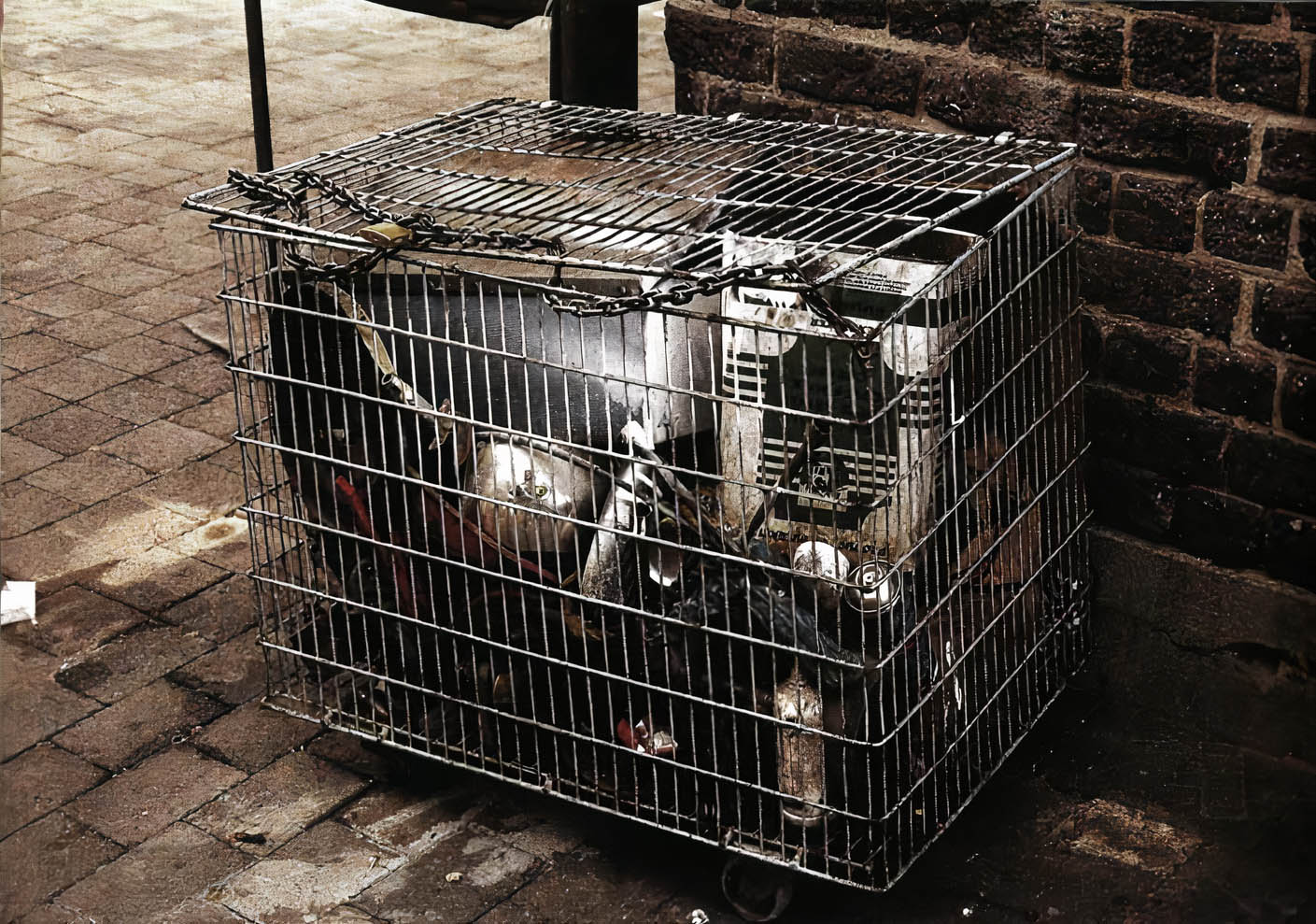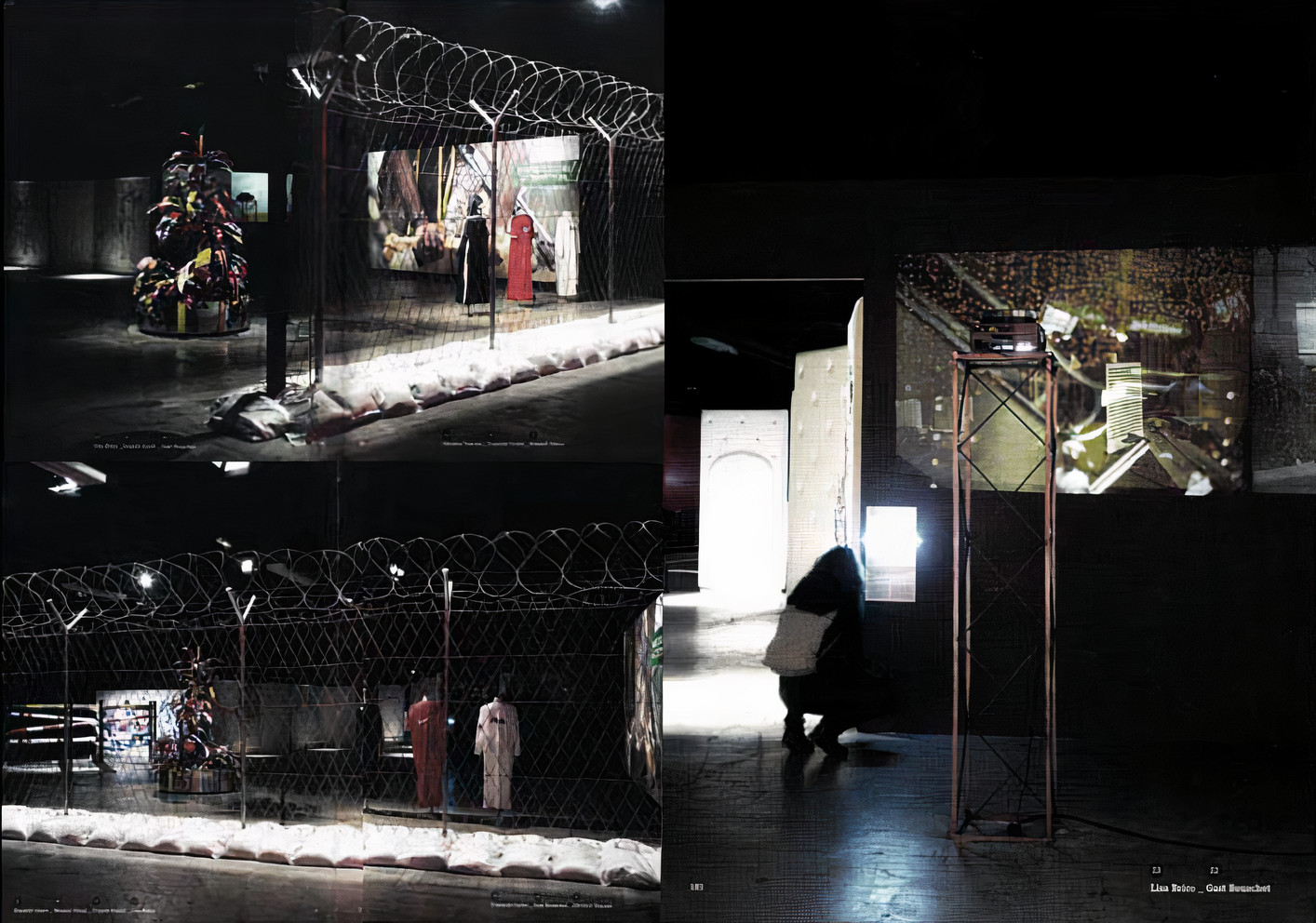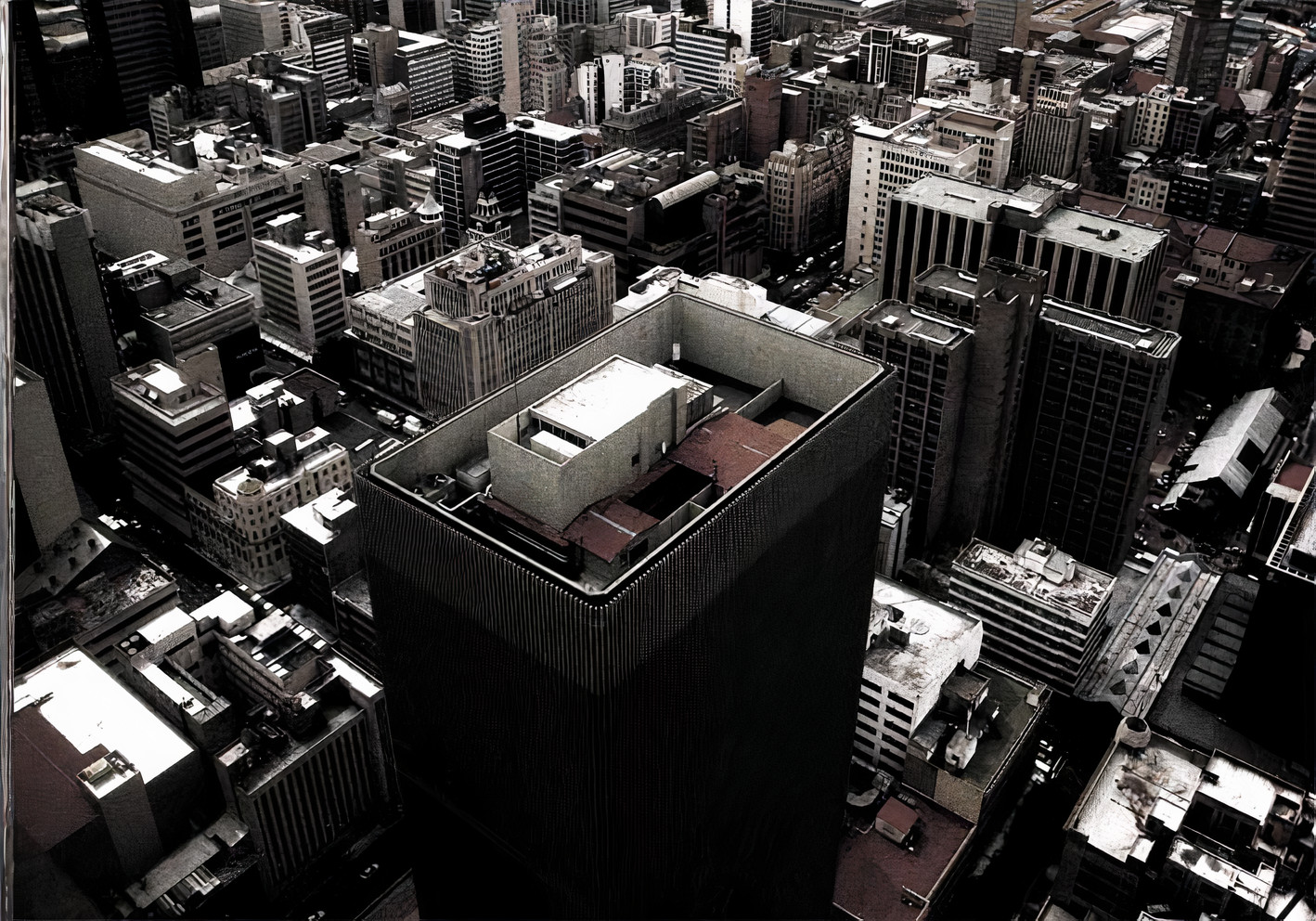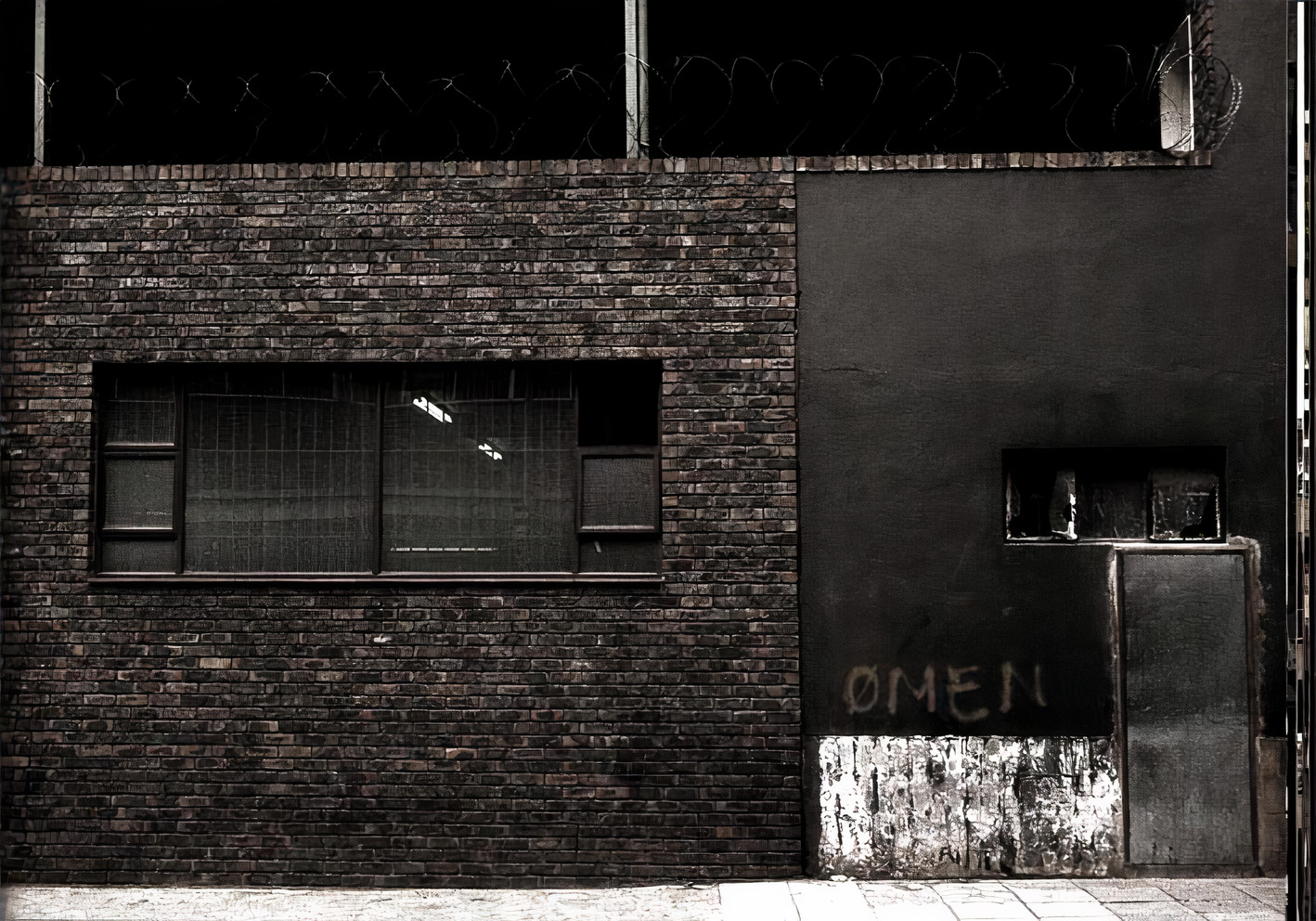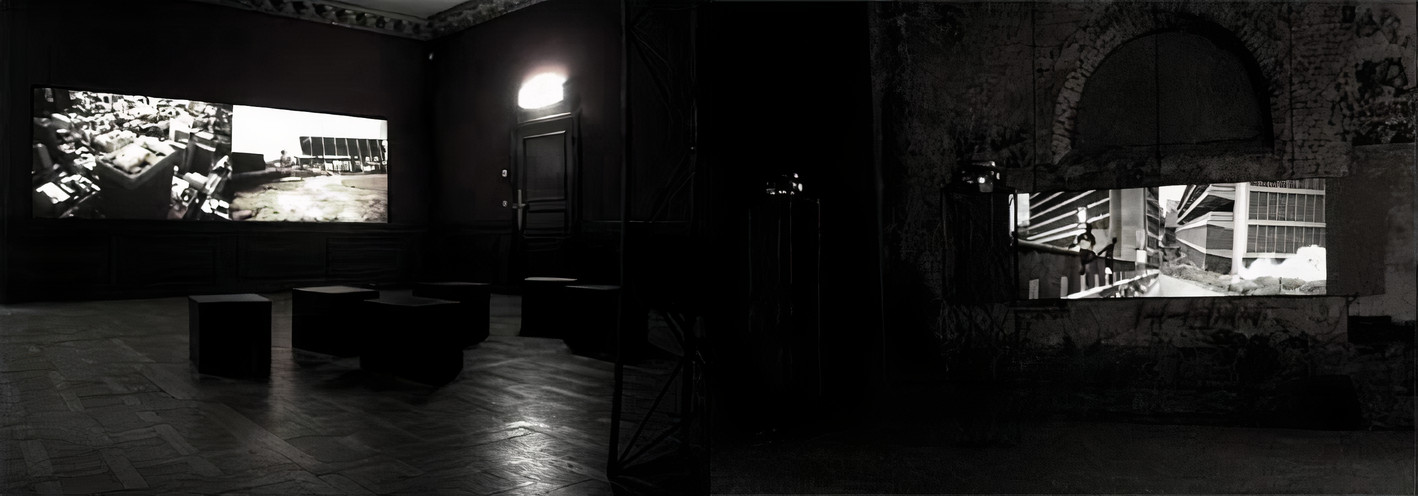THIS SPACE BETWEEN US
AREA RESIDENCY PROGRAMME JOHANNESBURG, SOUTH AFRICA, 2000
This Space Between Us, Solo Show at Camouflage Brussels, Belgium 2001
Wooden platform and double slide projection, 160 slides, sound, 25′ loop
Curator: Fernando Alvim
TSBU was exhibited at:
Camouflage Johannesburg, South Africa 2001; Camouflage Brussels, Belgium 2001; Centre National d’Audiovisuel, Luxembourg 2001; Casino Forum d’art contemporain, Luxembourg 2002; Biennale of Contemporary Art Busan, South-Korea 2002; BPS22 Charleroi Belgium 2003; Lille-Capitale Européenne de la Culture, France 2004; Curators Choice, Art Frankfurt, Germany 2004; Théatre Royal de Namur, Belgium 2007; Domaine départemental de Chamarande, France 2007.
A conference on ‘This space between us’ was held in Dudelange, Luxembourg in April 2002 with interventions by Danielle Igniti, Fernando Alvim, Claude Lorent, Simon Njami, Enrico Lungi and Gast Bouschet.
The divided Us
On more than one occasion, I have indicated that I consider space to be purely relative, just like time, for an order of coexistences, just like time is an order of successions. (Leibniz: letter to Clarke)
If Leibniz wrote that space was a purely relative notion and compared it to time, this was because we have to define the parameters of our own spaces, just as we do with time. Space is intangible in that simply by our presence we play a part in changing it. So there can be no such thing as neutral space, because space exercises a pull. Not as something vacuous, but as something possible. ‘This space between us’ is a complex and powerful work, since it takes us right to the heart of the notion of things possible. Consequently, it is open to infinite interpretations. And this was undoubtedly the first stroke of genius on the part of the artist – finding a title for his work that was like opening the door to infinity or passing us the inextricable thread of Ariadne. In order fully to grasp all its implications, it is essential to return to the origin of the project and put it in its context.
This work is the product of a residency in South Africa. And Gast Bouschet one should remember, comes from Luxembourg. So the first space he had to overcome was a physical one – the thousands of kilometers that separate Belgium, where he lives, and the southernmost tip of black Africa. These thousands of kilometers would in themselves be enough to impact on the notion of distance that all space presupposes. Yet the magic of travel lies not only in the physical displacement but also, and above all, in the intellectual alienation arising from the confrontation between one’s own culture and another.
And this is particularly true in the case of South Africa, where the displacement for someone white is not so obvious as, say, in Bangui or Lagos. Despite being an African city, Johannesburg is something completely different. There is already a physical, historical and intellectual divide between this Africa, which conforms more to the archetypes of race and place. So in making this journey, the artist was displaced on several levels as regards the mental image he has of Africa and the Africa that he is discovering. It is essential here to realise the importance of a city’s physical dimension, since Bouschet’s preferred medium is photography, and photography reproduces an illusion. Illusion because nothing is more deceptive than an image. It is the end product of the photographer’s state of mind, of his conditioning by his environment, and of the unconscious responses that are going to nurture his point of view. In other words the place, be it physical or psychological, from where he is going to take his pictures. So there can be nothing less objective and more personal than photography, since it is inevitably conditioned by the way we observe the world around us. Photography is about interpretation and taking a stance. And this is what the artist reminds us of, right through to the final presentation of his work.
This work is presented as a parallel projection of images in two screens. So the scenography starts by creating a distance between the public and the images. The photographs are projected on to the two screen alternately but with a slight time lag, keeping us constantly under pressure, since we have to make rapid choices about what we want to look at, as the images fade out and are replaced with what look like similar ones, but ultimately super-imposed as mental images in our memory. Only after some time has passed do we start to give sense to those images, that are backed by sound effects going beyond mere illustration and creating in us the state of mind, the artist wishes to impose. The images are stills – it is photography – but this in no way means they do not have their own inner movement, as if the artist were panning from horizon to horizon.
Once we have captured the first space the artist has created between us and the images, we slowly perceive the other space, perhaps the subject of the work, yet to me no more than a visual metaphor of it. This is the tip of the iceberg: there is an opposition between the two screens, two parallel worlds that will not be converging for quite some time – on the one hand a rural reality sometimes with post-industrial overtones, and on the other an urban reality sometimes more reminiscent of a more agrarian lifestyle. So at first glance, what we are offered to reflect upon is this rupture between two models of society that cohabit without ever meeting. But we, as spectators, cannot be content with this first analysis, because we know where we are. The artist knows too. And the images cannot be neutral. To talk of space in South Africa inevitably takes us back to the period of apartheid where rupture was politically managed and ideologically integrated. It was not only distance that separated the two social spaces.
The social and the racial were intrinsically linked and contributed to affirming the line of demarcation between the different components of South African society. We see this, but nowhere it is spelled out. A few allusions, perhaps, in the image that indicates a violent and over-armed society. But apart from that we are left to make up our own minds. As if the artist was saying to us: I have done my job, it’s now up to you to do yours. But our work as spectators cannot be complete if we have not understood the different elements that contribute to the work, of which we see only the end result. It seems to me that we need to see exactly how the artist got there and, for a brief moment, to try to see the world through his eyes. One could be misled into thinking ‘this space between us’ was the work of a sociologist, a neutral and meticulous memoirist. Far from it, it is a piece of autobiography concealed behind the ambiguity of the Us referred to in the title. In fact, this Us condemns Bouschet to a role other than that of a simple spectator. A nomad in essence, a foreigner in Luxembourg, his country of origin, just as he is in Belgium, his adopted homeland, the artist happily assumes his adopted role. A nomad also by conviction he sets out to appropriate the world in the least serious way possible – as a visitor. But this status as an artist precludes distance, because what he sees, from wherever in the world he sees it, impacts on his personality. In the words of the psychologist, Roustan-Burgelin, ‘the idea of space is the representation of a homogeneous environment, with no limits, with no specific sensitivity, in other words empty but capable of being filled by any form of matter. It is the idea of a vessel, indifferent to its content, a framerwork within which our sensations are manifested and juxtaposed, that it in no way destroyed or altered when they disappear.’ Bouschet has resolved the issue of manifesting his sensations by including himself in the composite Us. This Us is himself and South Africa, and this space between the two is clearly signified by his status as a foreigner. The Us could also be an appropriation of the quality of being South African. Such appropriation inevitably leads to a commentary that no longer comes from outside but from inside. A message addressed to South Africans by someone who feels no sense of obligation towards any given nation and therefore feels free to claim that the world belongs to him and to intervene in a debate that others might think was nothing to do with them but that Gast Bouschet identifies with.
And lastly, this space could also be the space that separates us simple mortals from the magic of creativity. But Bouschet’s observation is not at all pessimistic, far from it. Designating a space is inevitably asking for it to be filled. Space is essential to communication. It can stem from fear or hatred, but also from longing or love. It can be a plea to come closer together. To fill it completely would be to deny the very dynamic of life. The aim of the humanity of which for an instant Bouschet becomes the spokesman is not to fill but to reduce. And the strength of a work as open as this is that, at a given moment, it becomes charged and belongs to us as well. It transforms us from being outsiders, into being part of this Us invoked by the artist. As I discovered his work, I, the African from Paris and Lausanne, stepped into his shoes. I followed the uninterrupted wanderings through this space he had decided to enter. I saw through his eyes a South Africa that I have come to describe in the same terms. The complexity of a country at a turning point it its history that displays the contradictions between its urban and rural realities as an archetype on which to build its present. In this respect, Bouschet has become african. Without any pretensions and remaining loyal to his own ideals, by allowing himself to be drawn into what these walls, billboards, fields and barbed wire had to say to him. Without any preconceptions other than his own sensitivity and his own interpretation of the world, his own point of view. His strength lies in the fact that he has succeeded in sharing a few of these fragments with us, in enabling us to participate in something that seemed beyond our reach. Things have come full circle. As we look at what Bouschet saw, we catch ourselves seeing it too. And that perhaps was something he did not expect to happen.
(Simon Njami)
Le Nous partagé
Pour moi, j’ai marqué plus d’une fois que je tenais l’espace comme quelque chose de purement relatif, comme le temps; pour un ordre de coexistences, comme le temps est un ordre de successions.
(Leibniz, lettre à Clarke).
Si Leibniz écrit que l’espace est une notion purement relative, et le compare au temps, c’est bien parce que, comme le temps, il nous appartient de définir nos propres espaces. L’espace est intangible est en ce sens que, par notre seule présence, nous contribuons à le modifier. Ainsi, il ne saurait y avoir d’espace neutre parce que l’espace agit comme un appel. Non pas comme une vacuité, mais comme une possibilité. This space between us est une œuvre complexe et forte parce qu’elle nous plonge précisément au cœur de cette notion de possibles. Dès lors, elle s’ouvre à une infinité d’interprétations. Le premier talent de l’artiste a sans doute été celui-là. Trouver à son travail un titre qui soit comme une mise en abîme, un inextricable fil d’Ariane. Bien en saisir toutes les implications, il faut sans doute revenir à l’origine de ce projet et le restituer dans son contexte.
Ce travail est le fruit d’une résidence organisée en Afrique du Sud. Gast Bouschet, faut-il le rappeler, est Luxembourgeois. Ainsi, le premier espace qu’il lui a fallu combler est un espace physique. Les milliers de kilomètres qui séparent la Belgique où il vit et à l’extrémité méridionale de continent noir. Ces milliers de kilomètres suffiraient à eux seuls à jouer la notion de distance que suppose tout espace. Mais la magie du voyage réside non pas uniquement en ce déplacement physique, mais également et surtout dans le décalage intellectuel issu de la confrontation de sa propre culture avec une culture autre.
D’autant plus que dans le cas de l’Afrique du Sud, le déplacement, pour un être de race blanche, ne contient pas l’évidence que l’on pourrait expérimenter à Bangui ou à Lagos. En effet, tout en étant une ville africaine, Johannesburg est autre chose. Il existe déjà une césure physique, historique et intellectuelle entre cette Afrique-là et une autre Afrique, plus conforme aux archétypes de la race et de la localisation. Ainsi, en accomplissant ce voyage, l’artiste s’est trouvé déplacé à plusieurs niveaux. Dans l’idée résiduelle qu’il a de l’Afrique et dans l’Afrique qu’il découvre. Il est sans doute important de noter ici de noter l’importance de la matérialité d’une ville, puisque le support de prédilection de Bouschet est la photographie et que la photographie reproduit une illusion. Illusion parce que rien ne saurait être plus mensonger qu’une image. Elle est fruit de la situation mentale du photographe, de son conditionnement à ce qui l’entoure et des conclusions inconscientes qui vont nourrir son point. C’est-à-dire le lieu, qu’il soit physique ou psychologique, à partir duquel il va prendre ses images. Ainsi, il n’est rien de moins objectif et de plus personnelle qu’une photographie, puisque celle-ci est nécessairement conditionnée par le regard que nous portons sur le monde qui nous entoure. La photographie est interprétation et prise de position. C’est ce que nous rappelle l’artiste, jusque dans la présentation finale de son travail.
L’œuvre se présente sous la forme d’une double projection, sur deux écrans. Cette scénographie commence par créer une distance entre le public et les images. Les photographies sont projetées sur les deux écrans avec un décalage, ce qui nous contraints à être sans cesse sous pression, à opérer des choix rapides sur ce que nous allons voir, des fondus enchaînés sur des images apparemment similaires, et finalement, des surimpressions sur notre mémoire. Ce n’est qu’au bout de quelque temps que nous commençons à donner un sens aux images, dont la projection est appuyée par une sonorisation qui va au-delà de l’illustration mais contribue à nous plonger dans l’état voulu par l’artiste. Les images, bien que fixes, c’est de la photographie, n’en contiennent pas moins un mouvement intérieur, comme si l’auteur nous livrait un travelling très large.
Une fois vaincu ce premier espace que l’artiste a institué entre nous et ses images, nous commençons à percevoir l’autre espace qui est peut-être le sujet du travail, mais à mon sens, n’en est que la métaphore visible. Le côté émergé de l’iceberg: il y a une opposition entre les deux écrans. Deux mondes parallèles qui ne se rencontreront pas de si tôt. D’un côté nous est livré une ruralité qui parfois prend des accents post-industriels et de l’autre, une urbanité qui elle nous renvoie parfois à une société plus agraire. Ainsi, à première vue, c’est qui est offert à notre réflexion est cette rupture entre deux sociétés qui cohabitent sans jamais se rencontrer. Le spectateur que nous sommes ne peut pas se contenter de cette première analyse, parce que nous savons où nous sommes. L’artiste le sait aussi. Et les images ne peuvent pas être neutres. Parler d’espace en Afrique du Sud nous renvoie forcément aux temps de l’apartheid où la rupture était politiquement gérée, idéologiquement intégrée. Ce n’était pas uniquement la distance qui séparait deux espaces sociaux. Le social est le racial était intimement liés et contribuaient à affirmer cette ligne de démarcation entre différentes composantes de la société sud africaine. Nous voyons cela, alors que nulle part cela n’est souligné. Quelques allusions, peut-être, à travers cette image qui fait l’apologie d’une société violente et surarmée. Mais sinon, nous sommes livrés à nous-mêmes. Comme si l’artiste nous disait: j’ai fait mon travail, à vous de faire le vôtre.
Mais notre travail, nous spectateurs, ne peut pas totalement se faire si nous n’avons pas compris les différents éléments qui ont concouru l’oeuvre dont nous ne percevons que le résultat final. Il me semble nécessaire de se plonger un instant au coeur du cheminement de l’artiste et, l’espace d’un moment, d’essayer de voir le monde à travers son regard à lui. On pourrait se méprendre et penser que This space between us, est une oeuvre de sociologue, de mémorialiste neutre et méticuleux. Il n’en est rien. Il s’agit ici d’un morceau d’autobiographie qui se cache dans l’ambiguité du Nous cité dans le titre. En effet, ce à quoi nous condamne Bouschet est à ne plus être un simple spectateur. Nomade par essence, étranger au Luxembourg, son pays natal, comme en Belgique, son pays d’adoption, l’artiste se complait dans ce rôle assumé. Nomade par conviction il entend s’approprier le monde de la manière la plus logique possible. En visiteur. Mais son statut d’artiste lui interdit la distance, car ce qu’il voit, quelque soit le point du monde sur lequel il se trouve, influe sur sa propre personnalité. Selon les termes du psychologue Roustan-Burgelin, l’espace est la représentation d’un milieu homogène, non limité, sans qualité sensible qui lui soit propre, c’est à dire vide, mais susceptible d’être rempli par n’importe quel corps. C’est l’idée d’un contenant indifférent à son contenu, d’un cadre dans lequel nos sensations viennent s’étaler, se juxtaposer et qui n’est aucunement détruit ou altéré lorsqu’elles disparaissent.
Bouschet a résolu la question de l’étalage de ses sensations en s’incluant dans un Nous composite. Nous, c’est lui et l’Afrique du Sud, et l’espace entre les deux entités est clairement signifié par sa qualité d’étranger. Le Nous pourrait être aussi une réappropriation de la qualité de Sud-africain. Réappropriation qui conduit nécessairement à un commentaire qui ne provient plus de l’extérieur mais de l’intérieur. Un message adressé au Sud-Africains par quelqu’un qui, parce qu’il ne se sent aucun devoir envers aucune nation particulière, peut se permettre de dire que le monde lui appartient et intervenir dans un débat qu’un autre aurait pu juger éloigné de lui mais que Gast Bouschet reprend à son compte. Cet espace, enfin, est peut-être celui qui nous sépare, nous simples mortels, de la magie créatrice. Mais le constat de Bouschet est tout sauf pessimiste, au contraire. Désigner un espace, c’est forcément inviter à le combler. L’espace est un élément nécessaire à la communication. Il peut être fait de peur, de haine, mais également de désir et d’amour. Il peut signifier un appel au rapprochement. Le combler totalement serait nier la dynamique propre de la vie. Le réduire est le but de cette humanité dont Bouschet se fait l’espace d’un instant le porte-parole.
Et la force d’une oeuvre ouverte comme celle-ci, est qu’à un moment précis, elle devient investie et nous appartient aussi. Elle fait de nous, étranger, des parties de ce Nous que l’artiste invoque. En découvrant son travail, j’avais, moi l’Africain de Paris et de Lausanne, pris sa place. J’avais suivi sa déambulation ininterrompue dans cet espace qu’il avait décidé d’investir. Je reconnaissais, avec ses yeux à lui, une Afrique du Sud qu’il m’est arrivé de décrire avec les mêmes accents. La complexité d’un pays au tournant de son histoire et qui étale les contradictions de son urbanisme et de sa ruralité comme autant d’archétype d’une contemporanéité à batir. En ce titre, Bouschet est devenu Africain. Sans aucune prétention et à son corps défendant. En se laissant absorber par ce que les murs, les panneaux et les champs, les barbelés avaient à lui dire. Sans autre idée préconçue que sa propre sensibilité et sa propre lecture du monde. Son point de vue. Sa force est d’être parvenu à nous en faire partager quelques bribes. A nous faire participer à ce nous qui nous semblait hors de notre portée. Le piège s’est refermé. En regardant ce que Bouschet a vu, nous nous sommes surpris à le voir. Et cela, peut-être ne s’y attendait-il pas.
(Simon Njami, 2002)
This space between us… at Camouflage Johannesburg
“I believe in the power of images,” is one of the key points to emerge from a conversation with the artist Gast Bouschet in Johannesburg. Yet this is undoubtedly a daring statement given that the power of the image is regarded with great skepticism in Europe. The critic Hans-Christian Dany, for instance, identifies the (central European) art of recent years as art that is afraid of images and metaphors, as attention to the signs produced is becomes more and more selective. The reason for this, according to Dany, is the attempt to do justice to political correctness. Despite the obvious polemics of this analysis, it aptly identifies the problem that arises in assessing the photographic image as a critical instance with no credibility.
In the work that he created on site Gast Bouschet – the first artist in the international Residency Program “Area” of Camouflage Johannesburg – takes up the challenge of this phenomenon of the visual world focusing in particular on the communication structures of public space. In November 2000, Bouschet drove around Johannesburg and through the central northern part of the country for one month, intent on discovering the visual code systems and languages produced here. The results are presented now, two months later, in Camouflage Johannesburg. A slide and sound installation with 160 slides – projected on to two separate walls – shows images of details, some more eloquent than others, of architecture and landscape in between civilization and no man’s land. The backing for the slide projection is provided by a penetrating sound sampling of found everyday noises, media commentaries, and computer-generated sounds. For the artist, the views of architectural but also of interpersonal fringe phenomena provide an opportunity to use “street photography” to address some of the aspects of the conditions of public space as they currently exist in this country.
Gast Bouschet is most interested in the in-between zones, or rather the transitions from one system to another, from one state to another, from one material to another – from the visible to the invisible. He approaches these in-between zones both physically and mentally. He seeks out the different layers of images which could provide information about the regulation of public space and the conditioned behaviors that are consequently evoked.
For a video installation shown in Vienna in 2000, “listen to your holes”, for example, he traveled through the area of Colorado and Wyoming that acquired particular significance as a military base during the Balkan war. This is where the war in Europe was observed and controlled from underground. A few hundred meters above, on the surface, the residents of this area were confronted with reports on this war, thousands of miles away, in a way that was pictorially very concrete, but emotionally very abstract. Bouschet juxtaposed the video of this “survey of the surface” with a second video of a television recycling plant. In the collision of the two realities generated by civilization, which are essentially invisible, he initiated the question: How do the politics of the visible function? Who controls the way “fabricated” pictures are used? And to whom are they addressed? These questions are crystallized to an even greater degree in “this space between us…”
Code analysis naturally triggers the generalizable question: Where do you start with a complex system called South Africa, to which attach such significant terms as Rainbow Nation and multiculturalization in the field of the visible, or African Renaissance and post-colonialism in the field of the ideological? These terms are set on a crash course to hit us – non-Africans – direct. Should we rely on what we are told? On a small group of people, possibly even a closed community, that we meet? Or on so-called media reality? And how should we deal with the resulting collision with our own national – even eurocentric – identity? In his work, Gast Bouschet argues for a discussion with the obvious codes of an image culture in order to penetrate the actual essence of a system. The fascination of the country, according to Bouschet, stems from the dialectic of the dynamic and the static. The reason this is fascinating is that it is not immediately apparent to the short-term visitor. South Africa is a land of zones, which could just as well be termed worlds. Zones such as Johannesburg’s Disneyland ghetto Santon City and the township Alexandra, which are topographically juxtaposed, are the most obvious to mention here (and this is not the first time that this is recognized). However, the communication structures of public space diverge from one street to the next in a highly provocative way. And it is specifically this provocation that Bouschet wants to confront himself and the viewer with in “this space between us …”
Bouschet has tracked down locations/places that could be regarded as geographically, socially and economically heterotopic in the Foucaultian sense (i.e. places that have more than one meaning simultaneously). He finds these places primarily in so-called border areas, but areas which have a different definition or even several different definitions in each of these zones. Whether in the mall or on the street, in the city or in the country, in front of the border or behind it, the dynamic for the artist is found in these border areas. This focus is ultimately also interesting, because we Europeans have had to come to terms with the borderline, or with the so-called “space between us” in a very different way recently. Europe is suffering, as the latest Manifesta3 noted, from borderlessness. Border means an order that distinguishes between “this side” and “the other side.” “This side” is what is familiar, “the other side” is what is foreign, strange, to quote the Slovenian radical philosopher and psychoanalyst Slavoj Zizek in his most recent book “Love Thy Neighbor, No Thanks! The Dead-End of the Social in Postmodernism.” The central element in Zizek’s analysis is a criticism of the concept of democracy or so-called multicultural tolerance in globalized late capitalism. Its failure essentially consists in “simultaneously too much and not enough space being given to the particularity of the Other.” The Other is only tolerated in a premodern sense in the case of the folkloric. The real Other, however, is by definition “patriarchal and violent”, never the Other of charming customs: rather than a sublime person who is the object of my neighborly love, I find the real presence of my neighbor a nauseating conglomeration of flesh and blood discharging excrement. What does an analysis of the alien mean, then, in the context of South African reality, in which the folklorization of the Other has not yet even taken place? In a setting where the value systems of a “third world” and a “first world” confront one another? On which codes of which realities/truths should one focus? A postmodern European one? A post-colonialist African one?
Gast Bouschet’s response to this could be explained with the newly created term of so-called imagineering. Borrowed from visual studies, imagineering attempts to selectively illuminate the phenomenon of mass communication: rather than being concerned with the “what”, the imagineer is interested in probing the relationship of power and knowledge of an image. According to the concept, the point is not to uncover an authentic truth hidden “behind” the images, which would only further nourish “the ghost of transparency” (of a mainstream). The key is found in the way of dealing with “fabricated” images themselves.
In terms of imagineering, Gast Bouschet could well be interpreted as both a tracker and a transmitter, whose strength consists in creating an aesthetic surface, in which he is aware of various definitions of “the alien” and compares them with one another. By interlinking very different levels, he creates a matrix of multiple narratives. Image, text and sound worlds (a radio voice: “Next week we’re gonna take a look at how we can change the way we think”) reflect mass culture, migration policies, the cultural significations of various ethnic groups, economic racism, abuse of security policies or media cynicism. The viewer is positively bombarded with images. For Bouschet, this method not only serves the purpose of visualizing the power of the image codes, but in this way he also challenges the viewers to reflect on their own perception. With the technique of image sequencing, he removes the obvious narrative (to the extent that one can speak of narrative at all in photography) and replaces it with a chain of interfaces. In this concentration on architecture, street scenes or bizarre signs, such as “Harmony Shooting Club”, “Neighbors Dogs Driving You Mad?”, or “Trouble in the Land of Plenty”, dominant ideological formulas are put forward, but with expressions of resistance at one and the same time. And this is also the focus for his critical reflection on “fabricated” images. He compels the viewer to deal selectively with this visual information. Or to quote Hans-Christian Dany again: “If up until recently we had a moral obligation to deconstruct (Derrida), then – moving in the opposite direction – meaning must now be reconstructed, in other words we must now believe in the meaning of signs.” And this is what the project undoubtedly achieves.
(Maren Richter)
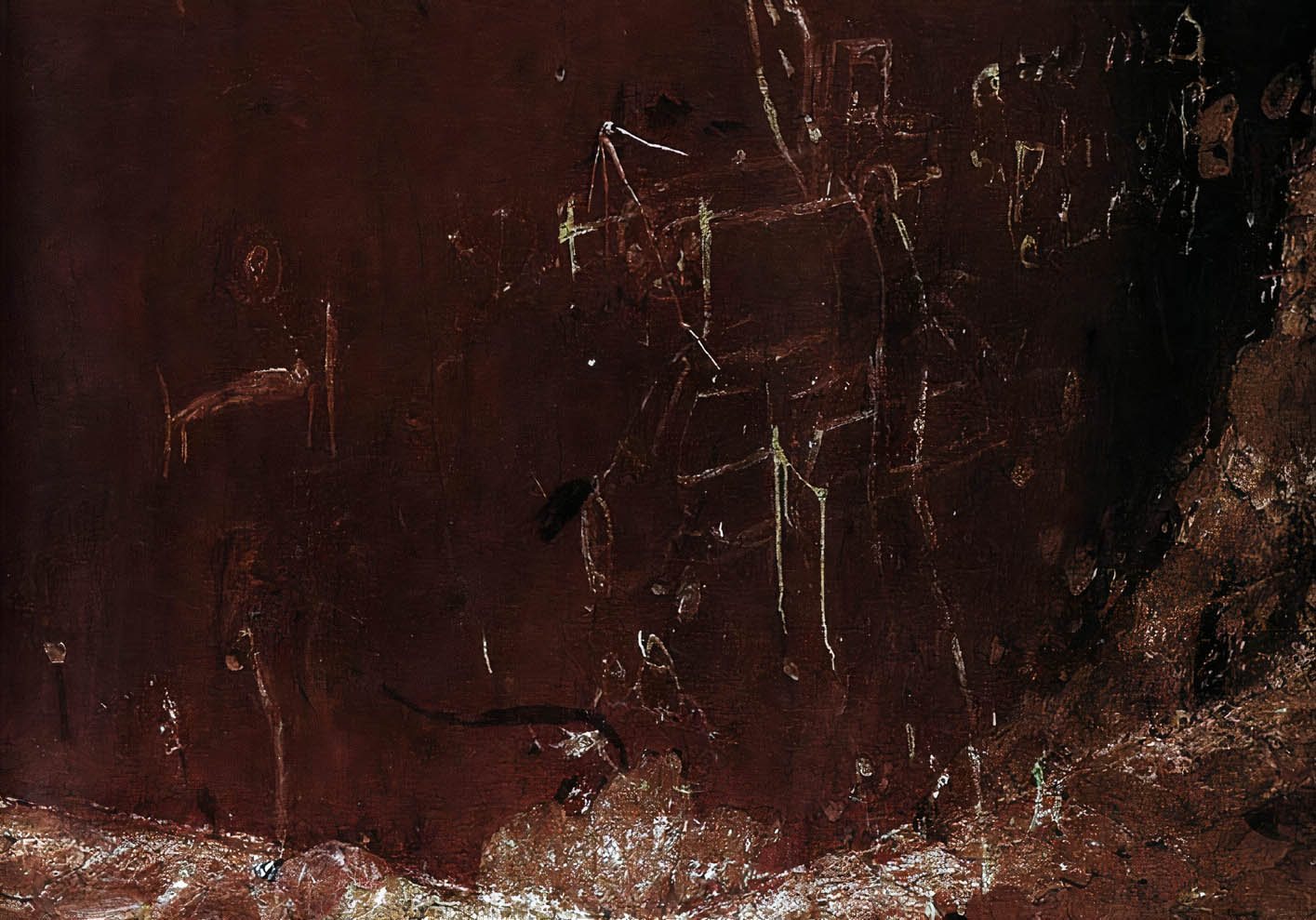
Graffiti in the streets of Joburg. You can’t see it clearly in this picture, but on the left side there is a drawing of a human body sleeping on a bed and dreaming about a head or skull, which is indicated by a speech bubble.
Dreamcatcher
After our arrival in Johannesburg, we were accommodated in a house in Rosebank, which was surrounded by an electric fence and surveillance cameras, like all houses in this area. However, the security measures were worthless as their payment had been suspended for over a year. To protect us from the violence of possible burglars, the director of the art center had hired a man to sleep in the entrance area of the house. His first name was George, and to be honest, at first glance he didn’t seem to be much help in warding off intruders. But then there was the heavy iron gate in the middle of the house that separated the bedrooms from the living area and testified to the ever-present fear of violent crime. We sat with George until late at night, and he talked at length about his life and his sister, who was a witch and would keep danger away from him and thus from us. An assurance he didn’t seem to fully trust, however, because he had just escaped from downtown Johannesburg, where he had lived in a squat for several months. He said he had to flee spontaneously because gangsters were after his life and had threatened to eat his heart. To put this in perspective, it is helpful to know that after the collapse of apartheid, the financially powerful companies left the center of Johannesburg. During the day, downtown Joburg now resembles a typical African city with its bustling street markets, but hardly anyone dares go there after sunset because armed gangs have taken over at night. George’s tales held a morbid fascination, and we could have listened and talked to him all night long, but eventually we fell over with fatigue, partly due to the cold Nadine and I had caught in Vienna a few days earlier. In the afternoon of the next day, George handed us a white powder that his sister had prepared for us, and Nadine put it straight up her nose without asking what it contained. I was more careful, but I should have taken it, because she recovered from the cold much faster than I did.
TSBU in Black Box, Lille-Capitale Européenne de la Culture, France 2004
Also pictured: Mounir Fatmi, Olivier Toscani, Franck Scurti, François Curlet, Kendell Geers, Lisa Brice.
Curator: Laurent Jacob
Intervention lors d’une conférence
Le projet d’exposition qui nous occupe porte sur «this space between us» et sur le travail effectué en résidence à Johannesburg, qui vous est présenté ici sous forme d’une vidéo où les images succèdent les unes aux autres, alors qu’en principe il s’agit de deux images juxtaposées et projetées dans un déroulement discontinu.
Ces trois éléments: la succession, la juxtaposition et le décalage temporel, constituent la première approche de cet espace d’entre les choses, un espace temps, un espace mental, un espace de réflexion, un espace de lecture et donc de culture. Ce qui n’est pas dit ou montré- explicitement participe totalement de ce travail et de la démarche générale de Gast Bouschet. On aura déjà compris que l’entre deux, que le non vu, que le non dit, que le non perçu, est aussi important que ce qui est montré et dès lors que les images proposées, sont en fait des catalyseurs d’une vision qui n’est plus simplement imagée, visuelle, mais dans laquelle se trament tout le sens, toute la profondeur, tous les questionnements de la démarche de l’artiste qui n’est pas du tout un faiseur d’images, mais un poseur de regards sur le monde. Pour lui, la question qui passe par l’objectif de son appareil à chaque déclic est en quelque sorte: comment j’appréhende ce monde dans lequel je vis en nomade.
Il y a donc – le Je: social, artistique, culturel, politique (sens noble du terme): en quelque sorte mon identité. Il y a le monde: ce qu’il offre, ce que j’en vois, les autres qui y vivent. Et il y la relation entre les deux: justement cet espace entre.
Gast Bouschet est un nomade avec domicile fixe, mais un nomade quand même car sa situation, sa position ne le satisfont jamais vraiment, de là où il est, il va constamment voir ailleurs, avec les moyens dont il dispose et cela dépend des circonstances. Je me souviens très précisément d’une photo prise d’une chambre d’hôtel, quelque part, sans appareil, simplement par le principe du sténopé. Une photo qui ne visait rien de spécial, juste ce que l’on pouvait voir à travers la fenêtre, dans un flou approximatif. Cet acte photographique est une manière de regarder activement, non de se contenter de voir, «ce qui m’intéresse a-t-il dit dans une interview, c’est ce que l’on découvre». En agissant ainsi, il s’oblige à découvrir, à aller à la rencontre, à quitter ce confort dans lequel il aurait pu se complaire. Et cela, cette image où il n’y a rien de particulier, prend tout son sens. L’artiste découvre son environnement temporaire et expérimente le mot est choisi à dessein- cet entre lui et le monde qui l’entoure le plus immédiatement.
Son attitude n’est pas différente qu’il se retrouve à Mexico, à Bruxelles ou à Jo’burg. A Bruxelles notamment où il est lui-même une sorte de nomade installé, à la fois citoyen et étranger, un occidental de culture, mais ni franchement francophone, ni néerlandophone, donc différent, d’un identité dyslexique pour utiliser le terme correspondant à la proposition qu’il fera à Luxembourg et qui lui convient et ce qu’il cultive finalement c’est cet entre deux identitaire, assez indéfinissable. Expérimentant totalement, et sa vie au quotidien, et dans sa démarche artistique, il fait des deux une sorte de Work in progress. En fait il nous dit que rien n’est stable, rien n’est définitif, rien n’est totalement ce qu’il paraît être, ni soi, ni le monde, et surtout, il nous dit que le travail est de situer là dedans, entre, de se reconnaître là où on ne s’y attend pas et d’être peut-être surpris là où on pensait avancer en terrain connu.
On pourrait par exemple se demander quelle est l’identité de cette œuvre réalisée à Bruxelles par un Luxembourgeois qui plus est nomade. C’est une œuvre d’entre. D’entre toutes ces données, d’entre toutes ces expériences vécues, d’entre toutes ces bribes d’identités conjuguées. Une œuvre d’addition de ces entre. La photo devient une sorte de processus de rencontre: une succession de rencontres, comme la succession des images qu’il fait défiler devant nos yeux et dont j’ai dit d’emblée que c’était l’un des éléments du travail. Et l’identité est en continuel devenir, elle est constamment hybride.
C’est aussi me semble –t-il exactement la proposition de son cheminement à Jo’burg. Il montre par le montage photographique, ce qu’il a vu de cet endroit qu’il découvre, ce qu’il en a retenu à travers ses clichés. Ce qui est frappant en cette suite, c’est justement un va et vient entre ce qui semble connu et ce qui pose un ailleurs, souvent par un simple détail. Dès lors, la question qui vient à l’esprit est ce: où suis-je? Est-ce vraiment une œuvre africaine ou un sujet africain? Comment je me positionne là et là-dedans? La ville, ses lumières, son animation, ne diffèrent pas vraiment d’autres, des petits buildings, des toits: cela pourrait être New York aussi bien que Jo’burg; les longs fils électriques en campagne, les bâtiments ou les friches industrielles, les mines… tout cela ressemble étrangement à quelques sites du Luxembourg ou du borinage en Belgique, et le travail doit y être identique, les aspects sociaux et culturels ne peuvent être très éloignés. Par contre, quelques paysages, l’immensité des espaces, des alignement de maisons, indiquent un changement géographique et quelques images particulièrement fortes, prises en direct, sur le vif, en reportage, donc en quelque sorte «véristes»,créent soudain un décalage important et induisent une situation socio-culturelle vraiment différentes: une arme dessinées sur une voiture (trouble in the land), ou une inscription: Harmony: shooting club! Dès lors la question devient sensiblement différente: comment tout en me reconnaissant pour une certaine part, je m’inscris là-dedans, sans oublier, et c’est capital, les gens, les autres?
Ainsi le rapport au monde s’établit par une succession et une juxtaposition d’expériences dans lesquelles rien n’est jamais totalement stable, dans lesquelles interviennent la position personnelle et le donné collectif auquel on appartient également.
Cela rend caduque les conceptions monolithiques habituelles et dichotomiques du genre: il y a l’Occident et l’Afrique, le Nord et le Sud, l’art africain et l’art occidental, la culture occidentales et la culture africaine, avec toutes les suites politico-démagogiques que l’on ne connaît que trop bien, et dont on nous repaît les oreilles dans des tas de conventions correctes. A Mexico, Gast Bouschet a surtout photographié des objets de la communication, des radios, des paraboles… comme s’il voulait saisir les images de ce qui transmet les messages du monde au monde, et s’interroger sur la situation d’être entre ces messages auditifs et visuels. Ce qui me fait dire que la photo chez lui n’est donc pas l’image esthétique ou le simple témoignage de ce qui est à voir, je dirais (bien que je n’aime pas beaucoup ce terme car il engendre énormément de confusions sur le plan artistique), qu’elle est conceptuelle dans la mesure où elle n’est pas l’illustration d’une idée, la traduction plastique d’une idée, mais au contraire, dans la mesure où elle conduit à penser, à réfléchir à un état d’être et de se comporter.
Ces images de lieux et de gens de la planète, apportent un type de vision du monde canalisatrice d’énergies, comme s’il s’agissait d’une réaction chimique constamment ré-alimentée et qui appelle des corrections constantes. Un travail comme celui-ci s’inscrit totalement dans l’expérience continue, ce qui en fait un travail risqué, toujours incertain, toujours en devenir, dont l’identité, on l’aura compris, est intrinsèquement plurielle et changeante. Par rapport à l’Afrique par exemple, il n’est pas un regard porté SUR, mais un regard porté avec, un regard impliqué, point doctoral, et en cela il est très différent parce qu’il ne se base pas sur des stéréotypes immuables. Le rapport – cet entre les choses -, pour revenir au concept de l’exposition et du travail, n’est plus du tout celui d’un dominé et d’un dominant, mais celui d’une rencontre évolutive où les accointances et les influences réciproques sont finalement beaucoup plus riches que les différences car une compréhension mutuelle s’y manifeste et après on peut aborder ce qui distingue avec sérénité et enrichissement. Dans ce type d’approche du monde, il y a interaction et c’est en cette interpénétration que la démarche s’avère agissante. Cet ESPACE ENTRE NOUS est interprété comme une aventure commune dans laquelle la photographie –puisque c’est de cela qu’il s’agit- est un catalyseur dans le sens où elle favorise un type d’appréhension du monde dont je viens de parler. Traitée comme elle l’est, elle aide à voir, elle maintient l’esprit en éveil, elle active la curiosité et anime la réflexion. Et dans ce sens, les dispositifs de vision mis en place au moment des expositions prennent une importance capitale en rendant le regard actif.
(Claude Lorent, 2002)
Intervention at a conference
The exhibition ‘this space between us’ is based on the work carried out by Gast Bouschet while on a residency in Johannesburg. Iit was conceived as two sets of juxtaposed images projected randomly. These three elements – consecutive, juxtaposed and random – constitue the first angle of approach to this so-called space between things, a temporal space, a mental space, a space for reflection, a space for interpretation, a cultural space. What is not explicitly said – or rather shown – plays in implicit part in this work and in Gast Bouschet’s work in general. So is that the in-between, the unseen, the unsaid or the unperceived, is in fact just as important as what is shown, and that the images proposed act as catalyst for a vision that is not just image-based, not just visual, but rather a blend of all that is significant, deep and questioning in the work of the artist. He does not make images; he offers different views of the world; For him, the question the camera lens focuses on each time the shutter clicks is in a way: how do I see this world I inhabit as a nomad? there is therefore – the Self: social, artistic, cultural, political (in the noble sense of the term): to some extent my identity. – then there is also – the world: what it offers, how I see it, and the other people who live in it. – And of course, there is the relation between the two: in other words this space between.
Gast Bouschet is a nomad, a nomad with a fixed address but a nomad all the same, because his situation, his position, never really satisfies him, and he is constantly looking elsewhere, with the means available to him. And that depends on circumstances. I have a very clear memory of a photo taken in a hotel room somewhere, without a camera, just using the pinhole technique. It didn’t show anything in particular, just what could be seen from the window, all a bit blurred. This photographic act is a way of looking actively, not being content with just seeing. As he said to me once in an interview: ‘What I’m interested in is what I can discover’. And so he is obliged to make discoveries, to go out and look for new experiences, to leave the comfortable environment in which he could have become complacent. And it is this which changes the image, this image of nothing in particular, with all its meaning. The artist discovers his temporary environment and experiments – I use the word intentionally – with what is between him and the world immediately around him. His attitude is the same whether he is in Mexico, Brussels or Johannesburg.
In Brussels in particular, he is a sort of settled nomad, at one and the same time a citizen and a foreigner, western by culture but neither French-speaking nor Dutch-speaking, and so in a way different, with a sort of dyslexic identity – to use the term for the proposition he will be presenting in Luxembourg, which suits him. Ultimately, what he is cultivating is this almost undefinable, in-between identity. He gives himself over totally to experimentation, both in his daily life an his art, and makes a ‘work in progress’ of them both. In fact, what he is saying is that nothing is ever stable, nothing is final, nothing is ever totally what it seems, neither oneself nor the world. And most importantly that what we have to do is to place ourselves amidst it, in-between, to discover ourselves where we didn’t expect to be and perhaps to be surprised , there on what we considered to be home territory. We could perhaps wonder about the identity of this work produced in Brussels by a Luxembourger, a nomad into the bargain. It is a work on the between – between all the information, all the experiences, all these fragments of fused identities. A cumulation of all these betweens.
Photography has become a sort of meeting process: a succession of encounters like the succession of images he flashes in front of us that I said at the outset was one of the characteristics of the work. This identity is in a continuous state of evolution; it is always hybrid. And this is also – so it seems to me – the proposition underlying hs Johannesburg work. Using photographic montage he shows us what he saw in this place he discovered, what he preseved of it in his slides. What is striking in the series of images is the to-ing and fro-ing between what seems familiar and what is elsewhere, often just the result of a simple detail. So the question then is: where am I? Is it really an African work or an African subject? Where do I fit into the picture? The city, its lights and life differ not really from other cities: the small buildings, the rooftops, it could just as easily be New York as Johannesburg; the endless electricity cables stretching cross-country, the buildings and industrial wasteland, and the mines, they all bear an uncanny likeness to sites in Luxembourg or in the Borinage in Belgium – work there must be identical, and the social and cultural identity cannot be very different. And yet some of the landscapes, the immense open spaces, the lines of houses indicate a change in geography, and some particurly strong images, direct shots taken ‘live’, jolt us into a different reality, throw up completely different socio-cultural contexts: a weapon painted on a car (Trouble in the land of plenty), or an inscription (Harmony Shooting Club). From then on, the question shifts: identifying myself to some extent with those images, how do I, not to mention – and this is essential – people, the others, fit into this context?
And so the relationship with the world is created by a succession and a juxtaposition of experiences in which nothing is ever totally stable, in which the personal and the collective – of which we are also a part – intervene. This renders meaningless the standard monolithic conceptions, the received dichotomies like: there is the West and Africa, there is the North and the South, there is African art and Western art, there is Western culture and African culture, with all the political and demagogic overtones that we know all too well, and are continuously fed to us in a plethora of correct conventions. In Mexico, Gast Bouschet photographed mainly objects of communication, radio transmitters, satellite dishes, etc. as if he wanted to capture images of the objects that transmit messages from one world to another and reflect on the relationship between auditive and visual messages. Which is why I would say that his photography is not about aesthetic images or visual accounts of what is to be seen but – although I dislike the term because it causes vast confusion in the art context – conceptual in that it is not the illustration or visual rendering of an idea, rather it leads to thought, to reflection on a state of being and a way of behaving.
These images of places and people from all over the world bring with them a type of world vision that channels energies, as if by a chemical reaction that is constantly in the process of regeneration and in continuous need of correction. Such a work subscribes totally to the canons of ongoing experience, laying it open to risk uncertainty and change, and conferring on it an identity which is intrinsically multifaceted and in constant flux. In relation to Africa, for example, it is not looking at its subject, but looking with it, thereby – and this is crucial – creating an implicit vision. It is not based on fixed assumptions, and it is here that originality lies. The relationship – this state of being between things – to return to the concept of the exhibition and the work being exhibited is no longer that between dominated and dominator; it is rather an ongoing encounter in which the reciprocal contacts and influences are ultimately much richer than the differences because there is mutual understanding and, once that has been established, the distinctions can be analysed calmly and positively. In this type of approach to the world there is interaction and interpenetration, and it is here that the work assumes its full significance. ‘This space between us’ is to be seen as a joint adventure in which photography – because this is what we are talking about – is a catalyst in that it flavours the type of perception of the world I have just been talking about. Used in this way, it helps us to see, keeps us mentally alert, triggers our curiosity and stimulates reflection.
(Claude Lorent, 2002)
Résidence et nomadisme
…Autre question posée par ‘this space between us’, c’est celle d’un entre-deux identitaire dû au statut de citoyen et à la fois d’étranger que l’artiste assume. A quoi l’artiste répondrait volontiers que ‘rien n’est stable, ni définitif, ni soi, ni le monde: le travail est de s’y situer’. Il affirmerait ainsi composer son oeuvre d’une succession de ces ‘entre-eux’ et, tandis qu’il se place lui-même dans une identité totalement hybride, il fait naître, par ses images, des ‘identités de rapprochement’. Il peut de cette manière constamment s’entremettre sans pour autant s’immiscer; Gast Bouschet aurait-il inventé un art comportemental qui se traduirait en images?
(Marie Boisseau, 2002)
Espace dyslexique et structure semi-nomade
L’art contemporain englobe aujourd’hui des pratiques plurielles, disséminées, mutantes, qui échappent à toute sorte de classification, ou plutôt qui les dépassent pour s’ouvrir à des champs d’investigation de plus en plus complexes. Parallèlement, les artistes sont confrontés à un réseau d’infrastructures (institutionnelles ou non) de plus en plus polymorphes, leur permettant la ‘monstration’ de leur travail artistique. This space between us de Gast Bouschet, qui a eu lieu ce samedi 13 avril à la mairie de Dudelange participe à ce phénomène complexe de ‘monstration’ de l’art contemporain…
Natif de Dudelange, l’artiste luxembourgeois est un faiseur d’images. Son médium est la photographie, mais son espace d’investigation dépasse largement le stricte cadre de la photographie. Lors de sa résidence d’artiste à Johannesbourg au Centre d’Art contemporain d’Afrique australe, Bouschet a photographié espaces ruraux et urbains, avec leurs architectures, leurs moyens de transport, leurs réseaux électriques, mais aussi tous ces espaces frontières, formées par ces sortes d’enclaves villageoises que sont les townships. Ne privilégiant aucune systématisation de point de vue, son système de double projection d’images photographiques propose au spectateur une alternance de vues aériennes, de gros plans, de plongées, de contre-plongées etc. qui se succèdent dans un défilé d’apparitions et de disparitions, au rythme d’une alternance asynchrone. Il en résulte une tension entre la confrontation de deux images, mais aussi entre l’espace de plage noire de l’entre-deux images avec les images-mêmes.
Le spectateur est plongé dans un champ associatif, où la juxtaposition, le décalage et la succession de ces images induisent un regard fragmentaire, multiple, riche d’interconnections, qui l’amène à saisir l’univers de Gast Bouschet comme un espace ‘dyslexique’ (dans le sens où on ne peut arriver à le déchiffrer totalement), une réalité toujours en devenir. A l’instar de ce regard pluriel inhérent à l’oeuvre, la visualisation de celle-ci dans différents lieux connaît, elle aussi, une succession temporelle, un aspect ‘in progress’. De fait, la résidence d’artiste qui a eu lieu entre la fin de l’année 2000 et le début de l’année 2001 a été suivie par une première exposition du travail à Johannesbourg, puis par une seconde exposition à Bruxelles et enfin par la conférence à l’Hôtel de Ville de Dudelange…
(Claire Noesen, Le Jeudi, 18 avril 2002)
Left: TSBU at Domaine Départemental de Chamarande, France, 2007, Curator: Judith Quentel
Right: TSBU at Théatre Royal de Namur, Belgium, 2007, Curator: Pierre Olivier Rollin
